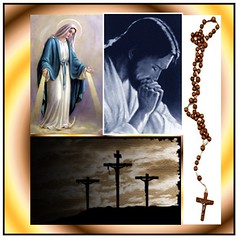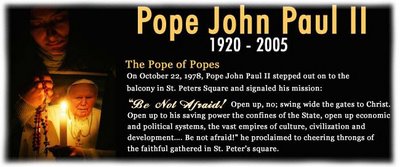 The Lord's Prayer
The Lord's PrayerOur Father, who art in Heaven, hallowed be Thy Name, Thy Kingdom come, Thy Will be done on earth as it is in Heaven. Give us this day our daily bread, and forgive us our trespasses as we forgive those who trespass against us. Lead us not into temptation, but deliver us from evil. Amen.
The Hail Mary
Hail Mary, full of grace, the Lord is with Thee. Blessed art Thou among women, and blessed is the fruit of Thy Womb. Holy Mary, Mother of God, pray for us sinners, now and at the hour of our death. Amen.
The Glory Be
Glory be to the Father, and to the Son, and to the Holy Spirit. As it was in the beginning, is now and ever shall be, world without end. Amen.
The Apostles Creed
I believe in God, the Father Almighty, Creator of Heaven and earth; I believe in Jesus Christ, His Only Son Our Lord, who was conceived by the power of the Holy Spirit, born of the Virgin Mary, who suffered under Pontius Pilate, was crucified, died, and was buried.
He descended to the dead; on the third day He rose again; He ascended into Heaven, and sitteth at the right hand of the Father; from thence He shall come again to judge the living and the dead. I believe in the Holy Sprit, the Holy Catholic Church, the Communion of Saints, the forgiveness of sins, the resurrection of the body and life everlasting. Amen.
Prayer to St. Michael, the Archangel
St. Michael the Archangel, defend us in battle, be our protection against the wickedness and snares of the devil; may God rebuke him, we humbly pray, and do Thou, O Prince of the heavenly hosts, by the power of God, cast into hell Satan and all the evil spirits who prowl about the world, seeking the ruin of souls. Amen.
The Angelus
Verse: The Angel of the Lord declared unto Mary,
Response: And She conceived by the power of the Holy Spirit. Hail Mary, full of grace, the Lord is with Thee...
Verse: Behold the handmaid of the Lord,
Response: Be it done unto Me, according to Thy Word. Hail Mary, full of grace, the Lord is with Thee...
Verse: And the Word was made flesh,
Response: And dwelt amongst us. Hail Mary, full of grace, the Lord is with Thee...
Verse: Pray for us, O Holy Mother of God,
Response: That we may be made worthy of the promises of Christ. Let us pray:Pour forth, we beseech Thee, O Lord, Thy grace into our hearts; that, we to whom the Incarnation of Christ, Thy Son, was made known by the message of an Angel, may by His Passion and Cross, be brought to the Glory of His Resurrection, through the same Christ, our Lord. Amen.
Glory be to the Father, and to the Son, and to the Holy Spirit... (3x)
The Memorare
Remember, O Most Gracious Virgin Mary, that never was it known, that anyone who fled to Thy protection, implored Thy help or sought Thy intercession, was left unaided.
Inspired with this confidence, I fly unto Thee, O Virgin of Virgins, thy Mother.
To Thee I come, before Thee I stand, sinful and sorrowful. O Mother of the Word Incarnate, despise not my petitions, but in Thy mercy, hear and answer me. Amen.
The Hail Holy Queen
Hail, holy Queen, mother of mercy, our life, our sweetness, and our hope. To thee do we cry, poor banished children of Eve. To thee do we send up our sighs mourning and weeping in this valley of tears. Turn then, most gracious advocate, thine eyes of mercy toward us, and after this our exile show us the blessed fruit of thy womb, Jesus. O clement, O loving, O sweet Virgin Mary.
Pray for us, O Holy Mother of God. That we may be made worthy of the promises of Christ.
Let us pray, O God, whose only begotten Son, by His life, death, and resurrection, has purchased for us the rewards of eternal salvation. Grant, we beseech Thee, that while meditating on these mysteries of the most holy Rosary of the Blessed Virgin Mary, that we may both imitate what they contain and obtain whatthey promise, through Christ our Lord. Amen.
The Fatima Prayer
O my Jesus, forgive us our sins, save us from the fires of hell, and lead all souls to Heaven,
especially those who need most of Thy Mercy.
 From
that day on the little boy discontinued his daily ‘Hail Mary’ and gave
himself more time to reading the Bible instead. One day, while reading
the Gospel, he came across the passage about the Annunciation of the
Angel to Our Lady. Full of joy, the little boy ran to his mother and
said: ‘Mummy, I have found the ‘Hail Mary’ in the Bible which says:
‘Hail Mary full of grace, the Lord is with thee, blessed art thou
amongst women. ‘ Why do you call it a superstitious prayer?’
From
that day on the little boy discontinued his daily ‘Hail Mary’ and gave
himself more time to reading the Bible instead. One day, while reading
the Gospel, he came across the passage about the Annunciation of the
Angel to Our Lady. Full of joy, the little boy ran to his mother and
said: ‘Mummy, I have found the ‘Hail Mary’ in the Bible which says:
‘Hail Mary full of grace, the Lord is with thee, blessed art thou
amongst women. ‘ Why do you call it a superstitious prayer?’












